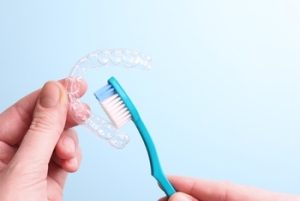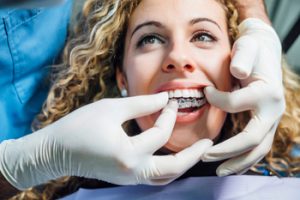Are you looking for a simple way to straighten teeth without metal braces? Invisalign might be the answer! This treatment uses clear aligners to gently move your teeth gradually into the right position. It’s a modern and easy way to get the smile you’ve always wanted. But how does Invisalign work?
In this article, we’ll explain the answer to that question step by step and why it may be a great option for you.
What Is Invisalign?
This is a modern and convenient teeth straightening process that doesn’t rely on metal braces. Invisalign treatment involves using clear, custom-made plastic trays that fit over your teeth.
Here’s what makes Invisalign unique:
- Clear And Invisible: The aligners are transparent, so most people won’t even notice you’re wearing them.
- Smooth And Comfortable: Made from soft plastic, the aligners don’t irritate your mouth like metal braces can sometimes.
- Removable: You can take the aligners out when eating, brushing, or flossing, which makes it easier to maintain good oral hygiene.
- No Food Restrictions: Enjoy all your favourite foods without worrying about damaging wires or brackets.
 How Does Invisalign Work?
How Does Invisalign Work?
Invisalign works by moving your teeth into the correct position over time. Each aligner is worn for a few days before you switch to the next one in the series.
Whether you want to fix crooked teeth, close gaps, or improve your bite, Invisalign can help you without disrupting your daily routine.
Invisalign Treatment Process
Invisalign helps straighten teeth without making you feel self-conscious about how you look. What’s even better is that this orthodontic treatment is simple.
Here’s how it works:
Step 1: Initial Consultation
Your Invisalign process involves meeting up with the dentist. During this meeting:
- The dentist will examine your teeth and gums.
- You’ll talk about your goals for a straighter smile.
- The dentist will decide if Invisalign is the right option for you.
This is an exciting first step to learning how Invisalign can transform your smile!
Step 2: Custom Treatment Plan
If Invisalign is the right choice for you, the dentist will create a custom treatment plan. This involves:
- Digital Scans Or Impressions: The dentist will take pictures, scans, or moulds of your teeth.
- Mapping Your Progress: Using specific software, the dentist will plan how your teeth will move.
This plan acts like a map, guiding your teeth through the straightening process.
Step 3: Making Your Aligners
Once the treatment plan is ready:
- A set of aligners is made just for you.
- Each aligner is designed to fit your teeth perfectly.
- The aligners are crafted to gently shift your teeth a little bit at a time.
These aligners are the tools that help bring your new smile to life!
Step 4: Wearing The Aligners
Here’s how to use your aligners:
- Daily Wear: You’ll wear them for 20–22 hours daily.
- Switch Aligners: Every 1–2 weeks, you’ll start wearing the next aligner in the series.
- Remove When Needed: You can take them out to eat, brush, and floss.
Wearing your aligners as instructed is key to keeping your treatment on track.
Step 5: Regular Checkups
Throughout your treatment, you’ll visit the dentist regularly. During these checkups:
- The dentist will check your progress to be sure your teeth move as planned.
- Adjustments can be made if needed to keep everything on track.
These visits are quick and help make sure you’re getting closer to your dream smile!
Step 6: Finishing The Treatment
When your teeth are in their new position:
- You’ll stop wearing aligners and start wearing retainers.
- Retainers help keep your teeth in place and maintain your new smile.
This final step is essential for protecting all your hard work during treatment.
Invisalign treatment is designed to be simple, comfortable, and effective. With regular checkups and consistent aligner wear, you’ll be on your way to a straighter, healthier smile in no time!
How Is Invisalign Different From Metal Braces?
Both Invisalign and traditional metal braces help straighten teeth, but they work in very different ways.
Here’s a quick comparison of Invisalign and metal braces:
- Appearance:
- Metal braces are noticeable with brackets and wires.
- Invisalign aligners are clear and blend in with your smile.
- Flexibility:
- Metal braces are on your teeth 24/7.
- Invisalign can be removed for cleaning and meals.
- Comfort:
- Metal braces may irritate your mouth.
- Invisalign aligners are made from gentle plastic and feel comfortable.
- Daily Life:
- With metal braces, you may need to avoid certain foods like popcorn or sticky lollies.
- With Invisalign, you are free to eat any food you like after removing the aligners.
Talk to your dentist about your goals to decide which treatment is right for you. They can help you enjoy a straighter, healthier smile!
Who Can Use Invisalign?
Invisalign is designed to help with many common dental issues. Here are some of the problems Invisalign can fix:
Misalignments For Teens And Adults
Invisalign works best for people whose teeth have already stopped growing. This means that it’s a great option for:
- Teens who have finished growing.
- Adults who want to straighten their teeth without using metal braces.
If you’re still growing, your dentist may suggest other options or wait until you’re a little older.
Crooked Teeth
If your teeth are not straight, Invisalign can gently move them into the right position. This helps you achieve a more even and confident smile.
Gaps Between Teeth
Do you have spaces between your teeth? Invisalign aligners can close those gaps, making your teeth look more uniform and helping with better oral health.
Overbites, Underbites, Or Crossbites
Invisalign aligners can help correct these bite problems for better chewing and comfort. Here’s what each of them means:
- Overbite: When your upper teeth stick out too far over your lower teeth.
- Underbite: When your lower arch is in front of your upper arch.
- Crossbite: When some of your upper teeth appear like they’re inside your lower teeth.
Crowded Teeth
If your teeth overlap or there isn’t enough space in your mouth, Invisalign can help. It gently moves your teeth to create the right space and improve their alignment.
Talk To Your Dentist
If you’re unsure whether Invisalign is the right choice, your dentist can help. With the right guidance, you can decide if Invisalign is the best way to achieve your dream smile!
How Long Does Invisalign Take?
The time it takes depends on your teeth and how much they need to move. Invisalign dental treatments may last between 12 and 18 months. Your dentist will give you an estimated treatment duration during your first consultation.
Taking Care Of Your Aligners And Teeth
When using Invisalign, it’s very important to keep your teeth and aligners clean. This will help your treatment work better and keep your mouth healthy. Here are some simple tips to help you take care of them:
Brush Your Teeth After Eating
Wait 30 minutes after eating, and then clean your teeth before putting your Invisalign back in. This helps remove food and keeps your teeth clean. Food that gets stuck can cause bad breath or make your teeth dirty.
 Clean Your Aligners
Clean Your Aligners
Your aligners need to stay clean, too! To clean them:
- Use A Soft Toothbrush: A soft brush will help avoid scratching your aligners.
- Mild Toothpaste: Use gentle toothpaste to clean your aligners. Avoid harsh or strong toothpaste that could damage them.
Cleaning your aligners every day will keep them clear and free from stains.
Don’t Eat Or Drink With Your Aligners In
It’s best not to eat or drink anything (except for water) while your aligners are in your mouth. Eating or drinking with them on your teeth can:
- Cause food to get stuck in your aligners.
- Make your aligners dirty or stained.
- Impact how well your teeth move.
If you need to eat or drink, take your aligners out first.
Soak Your Aligners
You can soak your aligners in a cleaning solution every once in a while to keep them fresh and free from bacteria. Your dentist can give you tips on the best way to do this.
Keep Your Teeth Healthy
While you’re wearing Invisalign, it’s also important to keep your teeth and gums healthy. Here’s what to do:
- Brush Your Teeth: Brush your teeth well to keep them clean and healthy.
- Floss Every Day: Flossing helps you get rid of food and plaque that your toothbrush can’t reach.
- Regular Dental Checkups: Visit your dentist for necessary checkups and cleanings. They can check your progress and help with any questions you may have.
These tips ensure your aligners stay clean and your smile stays healthy while you straighten your teeth!
Frequently Asked Questions
Will Invisalign hurt?
Invisalign should not cause pain, but it may initially feel a little uncomfortable. This is normal because the aligners are gently moving your teeth. After a few days, the discomfort will go away. If you ever feel too much discomfort, talk to your dentist.
How often will I need to see my dentist during Invisalign treatment?
You must see your dentist for regular checkups, usually every 6 to 8 weeks. These visits help your dentist check your progress and make sure your teeth are moving as they should.
What happens if I don’t wear my aligners enough?
If you don’t wear your aligners for the recommended 20 to 22 hours a day, it can slow down your progress. Your teeth might not move as quickly, or your treatment might take longer. Follow your dentist’s instructions and wear your aligners as much as possible.
Can I still play sports with Invisalign?
Yes, you can still play sports during Invisalign treatment. If you play contact sports, you may want to wear a mouthguard to shield your teeth. Just remember to take out your aligners before playing.
What if I lose or damage my aligners?
If you lose or damage an aligner, call your dentist right away. They can guide you on what to do next. You may need to wear your previous set of aligners until your dentist provides a replacement.
Can I wear my aligners if I have a cold or other illness?
Yes, you can still wear your aligners if you have a cold. Yet, it’s important to follow good hygiene practices and keep your aligners clean. Talk to your dentist if you have any discomfort or need to remove your aligners more often for comfort.
Will Invisalign affect my speech?
When you first start wearing Invisalign, you might see slight changes to your speech. This is because the aligners fit over your teeth. Yet, this should go away as you get used to wearing them.
Can Invisalign work if I’ve already had braces in the past?
Yes, Invisalign can be a good option for people who have had braces in the past and need to make minor adjustments. Your dentist will check your records and determine if Invisalign suits your needs.
Conclusion
 Invisalign is a good option, whether you’re a teen or an adult. If you’re ready to make your smile better, talk to your dentist about Invisalign. They will help you decide if it’s the right choice and guide you through the whole process.
Invisalign is a good option, whether you’re a teen or an adult. If you’re ready to make your smile better, talk to your dentist about Invisalign. They will help you decide if it’s the right choice and guide you through the whole process.
In the end, Invisalign can give you the beautiful smile you’ve always wanted without the discomfort of traditional braces. Stick to your plan, and you should see amazing results!
If you want a straighter smile with Invisalign, we’re here in Castle Hill to help! Contact Beyond Infinity Dental today at (02) 8806 3799 to see if Invisalign is right for you. Our friendly team will be here for you through every step.
Sources
Borst H. What Is Invisalign? What You Need To Know [Internet]. Forbes Health. 2023 [cited 2024 Dec 20]. Available from: https://www.forbes.com/health/dental/what-is-invisalign/
Jones H. How Does Invisalign Straighten Teeth? [Internet]. Verywell Health. 2024 [cited 2024 Dec 20]. Available from: https://www.verywellhealth.com/how-does-invisalign-work-8673844
Colgate. Clear Aligners Or Metal Braces? Here’s How To Choose [Internet]. Colgate®. 2023 [cited 2024 Dec 20]. Available from: https://www.colgate.com/en-us/oral-health/adult-orthodontics/clear-aligners-or-metal-braces-heres-how-to-choose
Swain E. Teeth Staining With Invisalign [Internet]. NewMouth. 2024 [cited 2024 Dec 20]. Available from: https://www.newmouth.com/blog/invisalign-staining/









